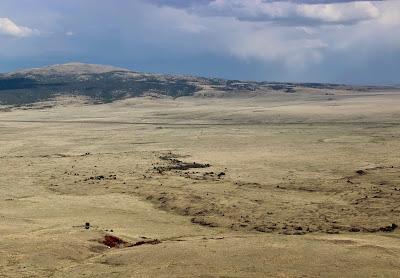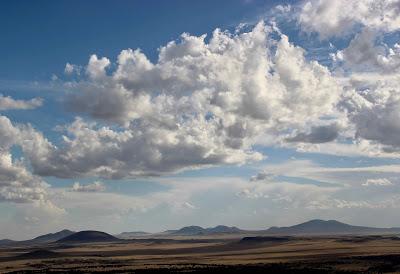
Capulín cinder cone, with lava flow (left) from a vent at the base of the cone.
On the west edge of the Great Plains in the northeast corner of New Mexico, at the northeast end of the mysterious lineup of volcanic features known as the Jemez Lineament, stands Capulín Volcano. It’s one of the youngest in the Raton Volcanic Field, having erupted just 60,000 years ago. Erosion has not yet destroyed its beauty, and much rock remains exposed, revealing some of its life story.
Capulín displays its beautiful symmetry.

Capulín's partially-vegetated lava flows are fascinating to explore.
Capulín is a cinder cone, a common and simple type of volcano. In shape, construction and composition, it very much resembles Paricutín in central Mexico, which erupted in a farmer's field just 75 years ago. Scientists were on hand to observe and describe Paricutín, from its birth in 1943 to its final gasp in 1952. Because the present is the key to the past, we can infer much about Capulín’s life from this modern-day example.

The infant Paricutín, just two days old. The cone is already 30 m tall (source).

Paricutín in the prime of life (1943; source).

Dead Paricutín, in 1997; note flow from side vent, a boca (source).
Now back to Capulín. Earthquakes probably were the first signs ofimminent birth. For weeks they grew in intensity, until an “especially violent tremor” opened a fissure that spewed steam and smoke, followed by glowing red magma. These first stage eruptions were relatively calm—lava oozed and flowed.

Black line marks extent of a first-stage lava flow, later covered by cinders and now grass (Sayer & Ort 2011).
But it wasn’t long before all hell broke loose. Gas-rich magma exploded upon reaching the surface, producing tall “fiery fountains” of fine volcanic ash, coarser cinders, and even bombs!—some weighing hundreds of pounds. Debris from repeated eruptions accumulated layer by layer to form a cinder cone more than 1500 feet tall. The road to the summit of Capulín crosses great exposures of layered volcanic debris. Unfortunately, there's no place to pull over before the parking lot at the top. However, the road is closed to traffic at the end of the working day and open to walkers.

Pale gray ash, coarse cinders and small bombs from the violent second stage of Capulín activity.

Large dark volcanic bomb, with medium dog for scale.
The Capulín crater is asymmetric, presumably because more debris accumulated downwind. It’s wonderfully accessible, with trails to the bottom and around the rim.

View into crater from trailhead.

Crater floor.

View north; prominent volcano on left and lava-capped mesa with snow in distance.
As gas was depleted, the dramatic eruptions subsided, giving way to a third stage of activity. No longer gas-propelled, magma couldn’t reach the top of cone, and instead flowed out vents on the sides, called bocas. (Spanish for mouth). These flows are the freshest of Capulín’s remains, still only partially vegetated. Two trails and the picnic area provide fine opportunities to examine the
“rocky desolate wasteland.”
Lava flows from Capulín and its neighbors (from Sayer & Ort 2011).
I saw plants colonizing rock everywhere I went. Some of the older flows appear mostly vegetated from a distance, but up close they're still rather rocky—just try walking across.

Partially vegetated flow along Lava Trail; Sierra Grande (volcano) on skyline.

Darker rocky tongue in grassland is an earlier lava flow (but post-cinder cone).

Gooseberry (Ribes sp.).

Young fringed sagebrush (Artemisia frigida).

Capulines on the crater rim. Capulín is the Spanish name for several wild cherries. The species in northern New Mexico is Prunus virginana—the chokecherry.
Flow surfaces cooled first, hardening into crust. But lava continued to ooze beneath, occasionally pushing through the crust to form tumuli or squeeze-ups. Some nice ones can be seen from the road to the park and along the lower trails.
Squeeze-up on Visitor Center Nature Trail.

Another tumulus, on the Lava Trail.

One more, near park entrance; vegetated lava flow in distance.
Not surprisingly, the Boca Trail tours the boca that was the source of Capulín’s final lava flows. The trail is relatively new—wear tough shoes and watch for trail signs.
Tastefully subdued sign (click on image to view).

This flat area is considered the remains of a lava lake, one of several in the Boca Trail area.
Geologists think Capulín was active for only a few years, but its life hasn't been dated precisely, only narrowed down to sometime between 62,000 and 56,000 years ago. Cinder cones typically are short-lived, erupting until they become clogged. Then they're done; they don't lie dormant. The Raton Volcanic Field probably is still active, but if Capulín’s magma source builds to erupt again, it will have to start all over, with another fissure spewing steam and smoke.

Baby Capulín is close by. Its lava covers parts of Capulin’s youngest flows, thus Baby is indeed younger.

A small part of the Raton Volcanic Field, viewed from the flank of Capulín.
Sources
Muehlberger, WR, Muehlberger, SJ, and Price, LG. 2005. High Plains of northeastern New Mexico, a guide to geology and culture. NM Bureau of Geology and Mineral Resources.Parent, L, McCristal, J, and Mathis, A. 1991 (and 2006). Capulín Volcano National Moment. Western National Parks Association (recommended; for sale at the Visitor Center, $3.95).Sayer, WO, and Ort, MH. 2011. A geologic study of the Capulín Volcano National Monument and surrounding areas, Union and Colfax Counties, New Mexico. New Mexico Bureau of Geology and Mineral Resources. PDF
